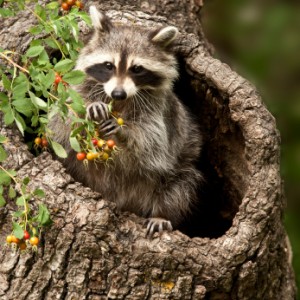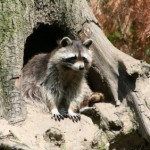Family, Description and Size:
The Raccoon is the largest member of the Procyonid family. It is also known as coon, raccoon or North American Raccoon. Raccoons are famous for their dense gray fur, their very dexterous hands and the “mask”-like white and black colors on their faces.
Their size ranges from 16 to 28 inches long, not including their large bushy tail that can range between 8 to 16 inches long by its own. Its shoulder height is on average about 9 to 12 inches and it weighs between 8 and 20 lbs.
Range and Habits:
The Raccoon is found all over North America, from Canada to Panama. Their populations have expanded from habitat near rivers or water sources, to many different types of areas and terrain. Raccoons prefer to live in habitats where there are vertical spaces to climb on for safety and shelter. This is why they prefer forests, especially those that have oaks and no trees that are too smooth to climb on, such as beech trees.
If they can’t find hollows in oaks and other trees to live in, the raccoon might use burrows dug by another species as a shelter. They don’t hibernate, but they will stay in their dens and sleep for days at a time if the temperature is below 25 degrees or so. Recently raccoons have moved into cities, where they thrive on human garbage and pet food, causing controversy as most want them removed while others feed them.
The raccoon is an omnivore and its diet consists mainly of insects and other invertebrates, small vertebrates and plants.
General Information:
Raccoons exhibit a behavior called dousing when they are about to eat something. This behavior has been mostly observed in captivity and consists of the Raccoon washing its food in water while trying to take off unwanted parts with its nimble hands.
Raccoons mate between January and March and they give birth to about two to five young sixty days later. Only the female raises the young or “kits” as they are called. After about a year the kits become sexually mature and are ready to reproduce.
Predators, Mortality and Lifespan:
Raccoons often die of disease and famine. Raccoons are carriers of rabies and were feared for a long time because of their role in spreading the deadly disease to humans. For that reason, wild Raccoons must never be pet or
handfed, no matter how docile they might seem.
The main predators of the Raccoon are the Bobcat, Coyote and the Great Horned Owl. A large part of the Raccoon population is hunted by humans for its dense fur that is used to make hats and other goods. Like most predators, licensed hunting does not hurt their numbers. Raccoons enjoy a healthy population and are on the least concern list of endangered animals.
Raccoons love to steal chicken and eggs out of the coops and can be a real menace to a farm. Their nimble fingers can open many simple doors that do not require keys and they also are excellent climbers, able to breach a chicken coop through its roof or windows. This is why when their population in a farming area reaches high numbers, they are often legally hunted or trapped to preserve the farm production.



